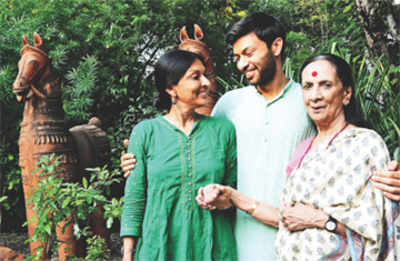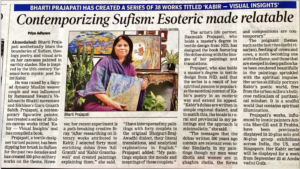
Whether facing brickbats or bouquets, Mrinalini, Mallika, and Revanta Sarabhai prove their strengths are divergent but it stems from their passion for dance, and the acceptance of each other’s uniqueness
The Sarabhais span three generations, but share one timeless tradition: dance. Mrinalini, 95, Mallika, 60, and Revanta, 29, form a trinity. United in their passion, they stand for the power of expression, individuality, and freedom.

Their characters personify this, too. Pandit Jawaharlal Nehru once invited Mrinalini, a renowned Bharatnatyam and Kathakali exponent, to give an exclusive performance. Mrinalini accepted the invite. However, giving in to her child’s demand, the Padma Bhushan awardee chose to call back and apologise to Nehru for not being able to perform “as her child needed her”. This was Mrinalini’s commitment as a mother.
On the other hand, her daughter Mallika, also a danseuse, social activist and Padma Bhushan, took her son Revanta along on most of her dance trips since he was three months old. “My commitment to my children also means being with them. The difference is that I took them where I went. While my mother chose to stay where her children were,” says Mallika, musing over their similarities and differences while Mrinalini nods with a majestic smile approving the observation.
Hearing this, Revanta, who is an independent performer, choreographer, multimedia designer and filmmaker to name the few hats he dons, puts forth, “I understand Amma’s (Mrinalini’s) call not to go, while I am also grateful that Maa (Mallika) chose to travel with me. Dance has come naturally to me. I have grown up watching her rehearsals.”
Yet, when he dances, Mrinalini sees more of her than Mallika’s reflection in him. “Revanta’s movements are delicate and graceful. I can identify with his bhava and nrutya. I do not see my image in Mallika. She is powerful, expressive and impressive,” the 95-year-old says.
IMPOSING PERSONAS
Mallika’s personality matches the persona of Draupadi, the character she presents in Peter Brook’s play The Mahabharata. Her sharp words and bold actions are as hard-hitting in real life as her solo theatrical works like Shakti: The Power of Women. She has vigour and force while Mrinalini’s personality manifests aesthetic appeal. The power of affection that flows through Mrinalini’s dance is at its best when she plays the role of Parashakti in her performances.
Meanwhile, Revanta, who juggles his professional and personal lives between London, Europe and India, shows the astute determination to do something creatively original. This trait is revealed through his choreography of Savitri: Flame of the Future — for which he collaborated with New York-based composer Joel Thome.
DEFINING DANCE
Mrinalini is perhaps the first classical dancer in India to have used the art form to talk of issues like dowry and violence against Dalits. However, she primarily remained a pure classicist. Mallika has been able to expand the repertoire by adding theatre, music and audio-visuals; while Revanta has enhanced the form by bringing in new technology, fresh thinking and vibrancy.
For Mrinalini, dance preserves and perpetuates tradition. For Mallika, it is an expression of questioning and reinterpreting; of turning myths and traditions upside down. And Revanta believes it is a passionate way of self-expression and each artiste’s expression is unique.
They may define dance differently, but when asked what they would have been if not what they are today, they unanimously crow: dancers!
Mallika quips, “I cannot be anybody but me. And I am happy to be what I am and where I am.” This is one of those rare thoughts on which the trio agrees.
“Amma is diplomatic and polite, while Maa is bold and honest. She says exactly what she wants to,” says Revanta who feels that he has a way of balancing differences and communicating a bold message in tender terms.
BOUND BY LOVE
Mallika affectionately accepts Revanta’s tag of being “extra candid”. She says, “I have always been open to my children and have answered their embarrassing queries. I have indulged in mom-baby talks for hours. When they are at fault, I have asked them to figure out their punishment. I have been a friend to my kids while Amma was a ‘Victorian-styled majestic mother’ who taught us through veiled messages. Today, I feel blessed when Amma calls upon me, and me alone, when she faces age-induced trauma. This is an opportunity to return the affection she showered on me when I was a baby.”
Mrinalini agrees: “Mallika is the only one who understands my old-age discomforts and tends to me with care. However, she also troubles me with her explicit honesty.”
Mallika’s daring political stand, honest statements and bold actions worry Mrinalini. In March 2009, Mallika had announced her candidature against Bharatiya Janata Party’s then prime ministerial candidate L K Advani for Gandhinagar Lok Sabha seat. Refuting public speculation, she had clarified that she was an independent candidate and not a Congress puppet, and that her candidature was a “satyagraha against the politics of hatred”. She lost by a heavy margin but there are many who revere her for her brave stand and clear political will.
Summing up her ongoing fights against the politics of hatred and violence inflicted on women, she says, “I feel passionate about certain issues. And, I feel a pressing need to speak for the people who cannot speak for themselves. I cannot be a mute observer of injustice. I have always been loud and have always done things openly.”
Revanta is impressed by his mother’s boldness and social activism but he is a thinker. He says, “I have to hear my inner voice on these issues. A strong conviction has to emerge from within. I do feel about these social issues, and respect Maa’s bold stand and honest fights. However, one has to think of the pros and cons of taking daring action. And I am still learning what my orientation is.”

